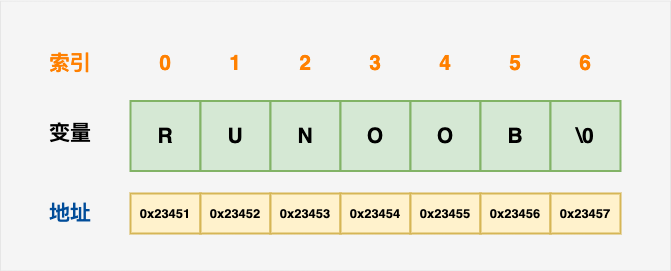C++ 字符串
C++ 提供了以下两种类型的字符串表示形式:
- C 风格字符串
- C++ 引入的 string 类类型
C 风格字符串
C 风格的字符串起源于 C 语言,并在 C++ 中继续得到支持。字符串实际上是使用 null 字符 \0 终止的一维字符数组。因此,一个以 null 结尾的字符串,包含了组成字符串的字符。
下面的声明和初始化创建了一个 ZHISHITU 字符串。由于在数组的末尾存储了空字符,所以字符数组的大小比单词 ZHISHITU 的字符数多一个。
char site[7] = {'R', 'U', 'N', 'O', 'O', 'B', '\0'};
依据数组初始化规则,您可以把上面的语句写成以下语句:
char site[] = "ZHISHITU";
以下是 C/C++ 中定义的字符串的内存表示:

其实,您不需要把 null 字符放在字符串常量的末尾。C++ 编译器会在初始化数组时,自动把 \0 放在字符串的末尾。让我们尝试输出上面的字符串:
实例
#include <iostream>
using namespace std;
int main ()
{
char site[7] = {'R', 'U', 'N', 'O', 'O', 'B', '\0'};
cout << "知识兔: ";
cout << site << endl;
return 0;
}
#include <iostream>
using namespace std;
int main ()
{
char site[7] = {'R', 'U', 'N', 'O', 'O', 'B', '\0'};
cout << "知识兔: ";
cout << site << endl;
return 0;
}当上面的代码被编译和执行时,它会产生下列结果:
知识兔: ZHISHITU
C++ 中有大量的函数用来操作以 null 结尾的字符串:
| 序号 | 函数 & 目的 |
|---|---|
| 1 | strcpy(s1, s2); 复制字符串 s2 到字符串 s1。 |
| 2 | strcat(s1, s2); 连接字符串 s2 到字符串 s1 的末尾。连接字符串也可以用 + 号,例如: |
| 3 | strlen(s1); 返回字符串 s1 的长度。 |
| 4 | strcmp(s1, s2); 如果 s1 和 s2 是相同的,则返回 0;如果 s1<s2 则返回值小于 0;如果 s1>s2 则返回值大于 0。 |
| 5 | strchr(s1, ch); 返回一个指针,指向字符串 s1 中字符 ch 的第一次出现的位置。 |
| 6 | strstr(s1, s2); 返回一个指针,指向字符串 s1 中字符串 s2 的第一次出现的位置。 |
下面的实例使用了上述的一些函数:
实例
#include <iostream>
#include <cstring>
using namespace std;
int main ()
{
char str1[13] = "zhishitu";
char str2[13] = "google";
char str3[13];
int len ;
// 复制 str1 到 str3
strcpy( str3, str1);
cout << "strcpy( str3, str1) : " << str3 << endl;
// 连接 str1 和 str2
strcat( str1, str2);
cout << "strcat( str1, str2): " << str1 << endl;
// 连接后,str1 的总长度
len = strlen(str1);
cout << "strlen(str1) : " << len << endl;
return 0;
}
#include <iostream>
#include <cstring>
using namespace std;
int main ()
{
char str1[13] = "zhishitu";
char str2[13] = "google";
char str3[13];
int len ;
// 复制 str1 到 str3
strcpy( str3, str1);
cout << "strcpy( str3, str1) : " << str3 << endl;
// 连接 str1 和 str2
strcat( str1, str2);
cout << "strcat( str1, str2): " << str1 << endl;
// 连接后,str1 的总长度
len = strlen(str1);
cout << "strlen(str1) : " << len << endl;
return 0;
}当上面的代码被编译和执行时,它会产生下列结果:
strcpy( str3, str1) : zhishitu
strcat( str1, str2): zhishitugoogle
strlen(str1) : 12
C++ 中的 String 类
C++ 标准库提供了 string 类类型,支持上述所有的操作,另外还增加了其他更多的功能。我们将学习 C++ 标准库中的这个类,现在让我们先来看看下面这个实例:
现在您可能还无法透彻地理解这个实例,因为到目前为止我们还没有讨论类和对象。所以现在您可以只是粗略地看下这个实例,等理解了面向对象的概念之后再回头来理解这个实例。
实例
#include <iostream>
#include <string>
using namespace std;
int main ()
{
string str1 = "zhishitu";
string str2 = "google";
string str3;
int len ;
// 复制 str1 到 str3
str3 = str1;
cout << "str3 : " << str3 << endl;
// 连接 str1 和 str2
str3 = str1 + str2;
cout << "str1 + str2 : " << str3 << endl;
// 连接后,str3 的总长度
len = str3.size();
cout << "str3.size() : " << len << endl;
return 0;
}
#include <iostream>
#include <string>
using namespace std;
int main ()
{
string str1 = "zhishitu";
string str2 = "google";
string str3;
int len ;
// 复制 str1 到 str3
str3 = str1;
cout << "str3 : " << str3 << endl;
// 连接 str1 和 str2
str3 = str1 + str2;
cout << "str1 + str2 : " << str3 << endl;
// 连接后,str3 的总长度
len = str3.size();
cout << "str3.size() : " << len << endl;
return 0;
}当上面的代码被编译和执行时,它会产生下列结果:
str3 : zhishitu
str1 + str2 : zhishitugoogle
str3.size() : 12